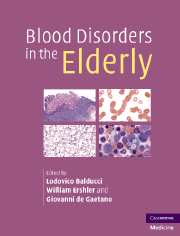Book contents
- Frontmatter
- Contents
- List of contributors
- Preface
- Part I Epidemiology
- Part II Hematopoiesis
- Part III Anemia of aging
- 12 Erythropoietin and aging
- 13 Iron and aging
- 14 Prevalence and mechanisms of B12 deficiency
- 15 Consequences of chronic anemia in the older person
- 16 The pathogenesis of late-life anemia
- 17 Treatment of late-life anemia
- Part IV Hematologic malignancies and aging
- Part V Disorders of hemostasis in the elderly
- Index
16 - The pathogenesis of late-life anemia
from Part III - Anemia of aging
Published online by Cambridge University Press: 21 October 2009
- Frontmatter
- Contents
- List of contributors
- Preface
- Part I Epidemiology
- Part II Hematopoiesis
- Part III Anemia of aging
- 12 Erythropoietin and aging
- 13 Iron and aging
- 14 Prevalence and mechanisms of B12 deficiency
- 15 Consequences of chronic anemia in the older person
- 16 The pathogenesis of late-life anemia
- 17 Treatment of late-life anemia
- Part IV Hematologic malignancies and aging
- Part V Disorders of hemostasis in the elderly
- Index
Summary
Introduction
As detailed elsewhere in this volume, anemia is often overlooked in the geriatric population. Historically, a decrease in hemoglobin concentration was accepted either as a part of “normal aging” or as a composite reflection of an underlying disease process. Currently, however, there is an evolving literature indicating the importance of anemia in older individuals with regard to physical and cognitive function, severity of comorbidities, and survival. For example, anemia may increase the risk for and severity of a number of age-associated diseases, including atherosclerosis, diabetes, Alzheimer disease, and osteoporosis. Furthermore, anemia is now considered an important component of the phenotype of frailty. Thus anemia has become a topic of increasing interest among investigators and clinicians in geriatric medicine. It has also become a focal point in hematology, as a precise explanation for the commonly observed normocytic anemia associated with advanced age (and especially frailty) has yet to be clarified.
Upon careful analysis, the occurrence of anemia may often be explained by any one of the well-understood mechanisms that result in anemia at all ages. However, in older patients, frequently more than one process is involved (e.g., iron deficiency and inflammatory disease). In fact, in 15–50% of the cases, a single prominent cause of anemia can not be identified, and this condition has been termed “anemia unspecified” or “anemia unexplained” (Table 16.1).
- Type
- Chapter
- Information
- Blood Disorders in the Elderly , pp. 203 - 213Publisher: Cambridge University PressPrint publication year: 2007



